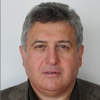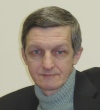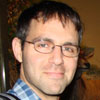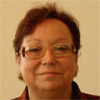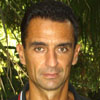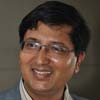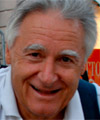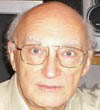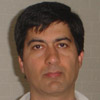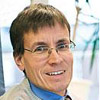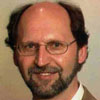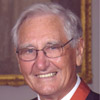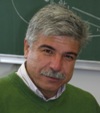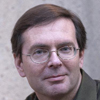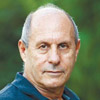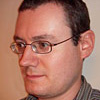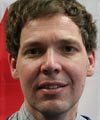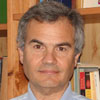Parallel Sessions Chairs (...preliminary list)
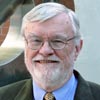 

|
David ARNETT Parallel Session: SN1 - Multi-Dimensional Codes for Supernova Explosions |
 

|
Neil ASHBY Parallel Session: SG1 SG2 - GR around the Earth and the Sun Description: The session deals with the recent advances in testing general relativity and alternative theories of gravitation around Earth and in the Solar System. This includes testing frame dragging and PPN gravitation with laser ranged satellites as well as with dedicated missions around Earth. Also important are the connections with geodesy and reference frames issues, now well known with the use of GPS. Testing general relativity in the framework of Solar System exploration is another important part, including the ongoing Cassini and the forthcoming BepiColombo. Modeling the dynamical environment of a probe in these different contexts is an important issue, and specific contributions in this direction are welcome. A special attention will be devoted moreover to tests of the Equivalence Principle. The verification of this cornerstone for many gravitational theories - in its various formulations - continues to be at the center of scientific interest, also for the potential impact that violations could have in our overall picture of the Universe. More info here: http://repos.ifsi-roma.inaf.it/~roberto.peron/MG13.html |
 

|
David BLAIR Parallel Session: GW3 - Status of the Gravitational Wave Detectors |
 

|
Victor FLAMBAUM Parallel Session: EG2 - Variation of Fundamental Constants Description: Space-time variation of fundamental constants from Big Bang to atomic clocks: theory and observations. |
 

|
Ariel GOOBAR Parallel Session: OC1 - Supernova Cosmology and the Accelerating Universe |
 

|
Roberto PERON Parallel Session: SG1 SG2 - GR around the Earth and the Sun Description: The session deals with the recent advances in testing general relativity and alternative theories of gravitation around Earth and in the Solar System. This includes testing frame dragging and PPN gravitation with laser ranged satellites as well as with dedicated missions around Earth. Also important are the connections with geodesy and reference frames issues, now well known with the use of GPS. Testing general relativity in the framework of Solar System exploration is another important part, including the ongoing Cassini and the forthcoming BepiColombo. Modeling the dynamical environment of a probe in these different contexts is an important issue, and specific contributions in this direction are welcome. A special attention will be devoted moreover to tests of the Equivalence Principle. The verification of this cornerstone for many gravitational theories - in its various formulations - continues to be at the center of scientific interest, also for the potential impact that violations could have in our overall picture of the Universe. More info here: http://repos.ifsi-roma.inaf.it/~roberto.peron/MG13.html |
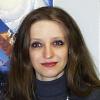 

|
Elena PIAN Parallel Session: SO3 - Observations from High Energy Astrophysics Satellites Description: SO3 summarizes recent results from high energy astrophysics observations with the main focus on space based satellites and observatories. The session primarily highlights observations from missions such as CHANDRA, XMM-Newton, Suzaku, Swift, Integral, and FERMI which are related to science involving strong gravity environments as found near neutron stars and black holes but also gravity environments on large scales such as clusters of galaxies. The session also includes science programs proposed for future missions. Observations relate to recent advances in gravitation, general relativity, field theories, experimental tests including relativistic aspects of high energy astrophysics. More details can be found at: http://space.mit.edu/home/nss/mg13.html . |
 

|
Felix RYDE Parallel Session: GRB1 - Photospheric Emission in GRBs Description: Early models of cosmological GRBs predicted the observed spectrum to be nearly blackbody. Observations were at odds with this prediction, and different theoretical models assuming optically thin emission have been put forward. However, models of such non thermal emission appear to be inconsistent with observations of steep spectra in early phases of many GRBs. Instead models involving photospheric emission producing modifed blackbody spectra explain such observed spectra quite naturally. We plan to discuss physical aspects of photospheric emission in ultrarelativistic sources as well as observational issues related to the detection of such a photospheric component in GRBs. Special attention is expected to be given to sub-photospheric dissipation mechanisms, geometric and dynamical effects, jet content, and additional components in the observed spectrum. More info: http://www.icranet.org/veresh/grb1 |
 

|
Misao SASAKI Parallel Session: CM1 - Inflation Description: Any topics about the inflationary universe. |
 

|
Norbert SCHULZ Parallel Session: SO3 - Observations from High Energy Astrophysics Satellites Description: SO3 summarizes recent results from high energy astrophysics observations with the main focus on space based satellites and observatories. The session primarily highlights observations from missions such as CHANDRA, XMM-Newton, Suzaku, Swift, Integral, and FERMI which are related to science involving strong gravity environments as found near neutron stars and black holes but also gravity environments on large scales such as clusters of galaxies. The session also includes science programs proposed for future missions. Observations relate to recent advances in gravitation, general relativity, field theories, experimental tests including relativistic aspects of high energy astrophysics. More details can be found at: http://space.mit.edu/home/nss/mg13.html |
 

|
Jesper SOLLERMAN Parallel Session: OC1 - Supernova Cosmology and the Accelerating Universe |
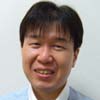 

|
Yukikatsu TERADA Parallel Session: SO4 - White Dwarf Pulsars and Rotating White Dwarf Theory Description: Pulsars are conventionally considered to be rotating neutron stars, which have been regarded as a textbook case of particle acceleration site emitting radiation in the wide energy band. Pulsars are the very simple system, rotating magnets. White dwarfs, having the same structures of magnetospheres as neutron stars, can have such activities. �Why we do not have White Dwarf Pulsars (WDP) when we have many kinds of neutron star pulsars� is a basic question in rotating magnetic compact objects. Recently, several observational approaches to search for white dwarf pulsars are performed in high energy photon bands. The aims of this section are 1) to focus on current results and future prospects of WDP observations and 2) to discuss on the particle acceleration process, emission mechanisms, and structures of magnetosphere etc of WDP in comparison with neutron-star pulsar cases. More info here: http://www.heal.phy.saitama-u.ac.jp/~terada/mg13so04.htm |
 

|
Gregory VERESHCHAGIN Parallel Session: GRB1 - Photospheric Emission in GRBs Description: Early models of cosmological GRBs predicted the observed spectrum to be nearly blackbody. Observations were at odds with this prediction, and different theoretical models assuming optically thin emission have been put forward. However, models of such non thermal emission appear to be inconsistent with observations of steep spectra in early phases of many GRBs. Instead models involving photospheric emission producing modifed blackbody spectra explain such observed spectra quite naturally. We plan to discuss physical aspects of photospheric emission in ultrarelativistic sources as well as observational issues related to the detection of such a photospheric component in GRBs. Special attention is expected to be given to sub-photospheric dissipation mechanisms, geometric and dynamical effects, jet content, and additional components in the observed spectrum. More info: http://www.icranet.org/veresh/grb1 |
 

|
Jean-Yves VINET Parallel Session: GW3 - Status of the Gravitational Wave Detectors |

